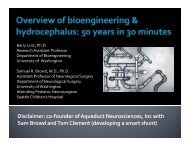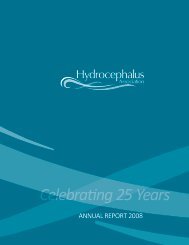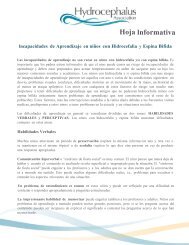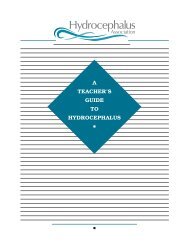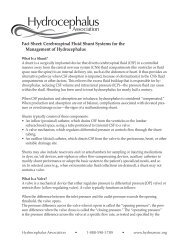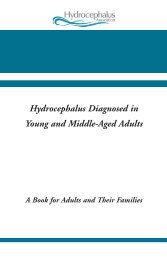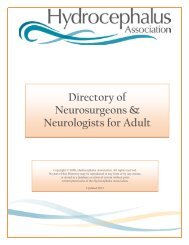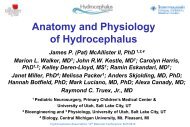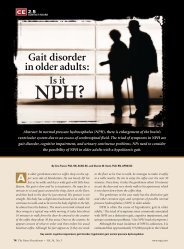Mechanisms in hydrocephalus revealed by neuroimaging
Mechanisms in hydrocephalus revealed by neuroimaging
Mechanisms in hydrocephalus revealed by neuroimaging
You also want an ePaper? Increase the reach of your titles
YUMPU automatically turns print PDFs into web optimized ePapers that Google loves.
Neuroimag<strong>in</strong>g approaches for elucidat<strong>in</strong>g<br />
disease mechanisms <strong>in</strong> <strong>hydrocephalus</strong><br />
Mark E. Wagshul<br />
Department of Radiology and Gruss MR Research Center<br />
Albert E<strong>in</strong>ste<strong>in</strong> College of Medic<strong>in</strong>e, Bronx, NY
An analogy: Cl<strong>in</strong>ico-radiological paradox<br />
Don’t treat the scan!
Neurology. 2012 Jul 3. [Epub ahead of pr<strong>in</strong>t]<br />
Three-day CSF dra<strong>in</strong>age barely reduces ventricular size <strong>in</strong> normal pressure<br />
<strong>hydrocephalus</strong>.<br />
Lenfeldt N, Hansson W, Larsson A, Birgander R, Eklund A, Malm J.<br />
RESULTS:<br />
• Dra<strong>in</strong> volume was 415 mL (median 470 mL, range 160-510 mL). Ventricular<br />
size was reduced <strong>in</strong> all patients, averag<strong>in</strong>g 3.7 mL (SD 2.2 mL, p < 0.001),<br />
which corresponded to a 4.2% contraction. The ratio of volume contraction to<br />
dra<strong>in</strong> volume was only 0.9%. Seven patients improved <strong>in</strong> gait and 6 <strong>in</strong><br />
attention. Ventricular reduction and total dra<strong>in</strong> volume correlated neither with<br />
improvement nor with each other. The 7 patients with the largest dra<strong>in</strong><br />
volumes (close to 500 mL), had ventricular changes vary<strong>in</strong>g from 1.3 to 7.5<br />
mL.<br />
CONCLUSIONS:<br />
• Cl<strong>in</strong>ical improvement occurs <strong>in</strong> patients with NPH after ELD despite unaltered<br />
ventricles, suggest<strong>in</strong>g that ventricular size is of little relevance for postshunt<br />
improvement or determ<strong>in</strong><strong>in</strong>g shunt function. The cl<strong>in</strong>ical effect provided <strong>by</strong><br />
ELD, mimick<strong>in</strong>g shunt<strong>in</strong>g, is probably related to the recurr<strong>in</strong>g CSF extractions<br />
rather than to the cumulative effect of the dra<strong>in</strong>age on ventricular volume.
Advanced imag<strong>in</strong>g techniques<br />
<strong>in</strong>sight <strong>in</strong>to function<br />
and structure/function relationships<br />
• CSF flow<br />
• Compliance<br />
• Blood flow<br />
• White matter <strong>in</strong>tegrity<br />
• Metabolism<br />
• Bra<strong>in</strong> function/connectivity
CSF flow<br />
Techniques<br />
• C<strong>in</strong>e phase contrast MRI<br />
• Quantitative measures<br />
SV, flow rate, peak velocity, …<br />
wide variability, technique/mach<strong>in</strong>e dependent !!<br />
<strong>Mechanisms</strong><br />
• “Redistribution”<br />
• Increased bra<strong>in</strong> pulsatility<br />
• Capillary pulsatility (pulse wave encephalopathy – ala Greitz)<br />
• Intracranial compliance
CSF flow – general f<strong>in</strong>d<strong>in</strong>gs<br />
Diagnosis<br />
• Luetmer (Neurosurgery 2002)<br />
18 ml/m<strong>in</strong> (flow rate)<br />
FR ~ SV * 2 * HR 130 ml<br />
Prognosis<br />
• Bradley (1996) - 42 ml<br />
• Prognostic value: Bradley (1996), Kim (1998), Henry-Fuegeas<br />
(2001), Egeler-Peerdeman (2001), Poca (2002)<br />
• No prognostic value: Parkkola (2000), Dixon (2002), Kahlon<br />
(2007), Abbey (2009), Alg<strong>in</strong> (2010)
There is abundant literature on the<br />
association of pulse pressure and<br />
coronary disease<br />
But is it causative?<br />
(From Dart, J Am Coll Card 2003)
NORMAL<br />
EXTRA-VENTRICULAR<br />
OBSTRUCTION HYDROCEPHALUS<br />
Artery<br />
PI<br />
1.0<br />
Parenchyma<br />
SAS<br />
Artery<br />
PI<br />
1.0<br />
Parenchyma<br />
SAS w/<br />
blockage<br />
CSF<br />
CSF<br />
Parenchyma<br />
Parenchyma<br />
Capillary<br />
PI<br />
0.15<br />
Capillary<br />
PI<br />
0.25<br />
Reduced Shear Forces<br />
Intact Blood-Bra<strong>in</strong> Barrier<br />
Functional Endothelial Transport<br />
Increased Shear Forces<br />
Altered Blood-Bra<strong>in</strong> Barrier<br />
Dys-functional Endothelial Transport
Toward mechanisms –<br />
Relationship between micro- and macro-pulsations<br />
300<br />
250<br />
Stroke Volume (nl)<br />
200<br />
150<br />
100<br />
Severe CH<br />
Mild CH<br />
50<br />
0<br />
0.1 0.15 0.2 0.25 0.3 0.35<br />
PI
Is there a relationship between ASV and compliance<br />
(<strong>by</strong> <strong>in</strong>fusion test)?<br />
Miyati et al, Eur Radiol 2003
Changes Is there a <strong>in</strong> relationship aqueductal between SV after ASV adjust<strong>in</strong>g and for volumetric<br />
confounders<br />
ventricular volume?<br />
10 patients<br />
(mostly NPH)<br />
10 controls<br />
Chiang et al, Invest Radiol 2009
Possible confounds –<br />
ASV changes over time (<strong>in</strong> untreated patients)<br />
Scollato et al, AJNR 2007
Possible confounds –<br />
Physiological variation <strong>in</strong> compliance
Majority of literature to date has been <strong>in</strong><br />
NPH/adults data are needed <strong>in</strong> pediatric HC<br />
Credit: Olivier Baledent, Amiens, France
4D phase contrast imag<strong>in</strong>g - but what does it mean?<br />
Stadlbauer et al, Neuroimage 2010
Complex CSF flow patterns <strong>by</strong> Time-SLIP method<br />
Yamada et al, Radiology 2008
time<br />
Real-time CSF flow dur<strong>in</strong>g physiological manipulation (Valsalva)<br />
“Image”<br />
Real time Flow<br />
Beat-to-beat SV<br />
Heart rate<br />
Resp. signal
Intracranial Compliance<br />
Techniques<br />
• Invasive techniques (e.g. <strong>in</strong>fusion test)<br />
• Vascular/CSF flow (Alper<strong>in</strong>)<br />
• MR Elastography<br />
<strong>Mechanisms</strong><br />
• ICP<br />
• Venous stenosis/hypertension<br />
• Gliosis<br />
• Pulsatility
How is Compliance Measured Invasively?<br />
•Marmarou et. al. J. Neurosurg, 1975<br />
Compliance = dV/dP<br />
Apparent Compliance = DV/(Pp-Po)<br />
DV <strong>in</strong> the order of several mL is used to overcome pressure pulsation<br />
MRICP is the non<strong>in</strong>vasive analogous of the volume-pressure response<br />
method, except that it does not <strong>in</strong>terfere with the craniosp<strong>in</strong>al hydrodynamics.<br />
MRICP measures the naturally occurr<strong>in</strong>g dV and dP with each heart beat.<br />
Credit: Noam Alper<strong>in</strong>, U. of Miami
CP Measurement <strong>by</strong> MRI: MR-ICP<br />
• MR-ICP is a non-empirical measure based<br />
on first pr<strong>in</strong>ciples of craniosp<strong>in</strong>al physiology,<br />
and fluid dynamics.<br />
• It utilizes MR velocity imag<strong>in</strong>g of the pulsatile<br />
blood and CSF flows to and from the bra<strong>in</strong>.<br />
• It does not require an <strong>in</strong>jection of a contrast.<br />
• MR-ICP scan (< 4 m<strong>in</strong>utes) is used as an<br />
add-on for a diagnostic bra<strong>in</strong> MRI exam.<br />
Diagnostic MR-ICP<br />
Related References:<br />
1. Alper<strong>in</strong> et al, Magn. Reson. <strong>in</strong> Med. 1996<br />
2. Alper<strong>in</strong> et. al. Radiology. 2000<br />
3. Loth FM, Yardimici MA, Alper<strong>in</strong> N. Jour. of Biomechan. Eng. 2001<br />
4. Alper<strong>in</strong> N and Lee SH. Magn. Reson. <strong>in</strong> Med. 2003<br />
5. Alper<strong>in</strong> et al. Current Medical Imag<strong>in</strong>g Reviews. 2006<br />
6. Ta<strong>in</strong> R and Alper<strong>in</strong> N. Jour. of Magn. Reson. Img. 2009<br />
Credit: Noam Alper<strong>in</strong>, U. of Miami
The Physiologic Basis of MR-ICP<br />
ICP is a mono-exponential function of <strong>in</strong>tracranial<br />
volume.<br />
At low ICP, a small change <strong>in</strong> volume (dV) causes a<br />
small change <strong>in</strong> pressure (dP).<br />
At high ICP, the same small volume change (dV) causes<br />
a larger pressure change (dP).<br />
The ratio dV/dP (compliance) is <strong>in</strong>versely related to ICP.<br />
MRICP measures dV and dP, to derive<br />
<strong>in</strong>tracranial compliance and pressure<br />
from imag<strong>in</strong>g of the blood and CSF<br />
flows to and from the cranial vault.<br />
Credit: Noam Alper<strong>in</strong>, U. of Miami
How is dV Measured?<br />
The systolic <strong>in</strong>crease <strong>in</strong> <strong>in</strong>tracranial volume (dV) is derived from the momentary difference<br />
between volumes of blood, and CSF that enter and leave the cranium dur<strong>in</strong>g the cardiac cycle,<br />
i.e., arterial <strong>in</strong>flow (red), venous outflow (purple), and cranio-sp<strong>in</strong>al CSF flow (yellow).<br />
Arterial<br />
blood <strong>in</strong><br />
Venous<br />
blood out<br />
ICV<br />
CSF<br />
out and <strong>in</strong>
How is dP Measured?<br />
• The pressure change (dP) dur<strong>in</strong>g the cardiac cycle is<br />
derived from the CSF pressure gradient (p), i.e., the<br />
pressure difference that causes the CSF to flow out from<br />
and back <strong>in</strong>to the cranium. 3<br />
• The Navier-Stokes equation is used to calculate CSF<br />
pressure gradient waveforms from the CSF velocities.<br />
dv/dt + v v-m v -p<br />
<strong>in</strong>ertial force<br />
viscous losses<br />
3-Loth FM, Yardimici MA, Alper<strong>in</strong> N. Jour. of Biomechanical<br />
Eng<strong>in</strong>eer<strong>in</strong>g. 2001, Vol. 123, pp. 71-79.<br />
Credit: Noam Alper<strong>in</strong>, U. of Miami
Intracranial compliance is<br />
decreased <strong>in</strong> NPH<br />
Miyati et al, JMRI 2007
MR Elastography<br />
Freimann et al, Neuroradiology 2012
Compliance is <strong>in</strong>creased <strong>in</strong> NPH<br />
Elastance<br />
Compliance<br />
Streitberger et al, NMR <strong>in</strong> Biomed 2010
… but no change <strong>in</strong> compliance with<br />
shunt<strong>in</strong>g (3 mo)<br />
Reconstitution of the micro-mechanical structure of the bra<strong>in</strong><br />
Freimann et al, Neuroradiology 2012
Is there a difference between global (ICP-mediated)<br />
and local compliance?
CBF<br />
Techniques<br />
– 133 Xe-CT<br />
– 15 O PET<br />
– SPECT ( 99 Tc/IMP)<br />
– ASL MRI (still under “development”??)<br />
<strong>Mechanisms</strong><br />
• ICP<br />
• Vascular compression<br />
• Impaired metabolism<br />
• Cardiac effects (??)<br />
Cause vs. effect still unknown
CBF – General f<strong>in</strong>d<strong>in</strong>gs<br />
• Global CBF reduced pre-shunt (mostly NPH)<br />
• Regions: mostly frontal & anterior temporal<br />
• Periventricular reduction<br />
• Not related to cl<strong>in</strong>ical function (correlations <strong>in</strong> limited # studies)<br />
• Post-shunt – <strong>in</strong>creased<br />
– related to outcome?<br />
Momjian et al, Bra<strong>in</strong> 2004
CBF <strong>by</strong> PET (NPH)<br />
CBF decreased, global and local<br />
(PVWM and GM)<br />
Note poor correlation between CBF and ICP<br />
weakens ventricular compression hypothesis<br />
Owler et al, JCBFM 2004
CBF <strong>by</strong> PET (NPH)<br />
CBF decreased locally (mesial frontal and anterior temporal)<br />
correlates with functional impairment<br />
Kl<strong>in</strong>ge et al, Cl<strong>in</strong> Neurol Neurosurg 2008
CBF <strong>by</strong> PCMRI<br />
• Increased with shunt<strong>in</strong>g (<strong>in</strong>fants)<br />
• Correlates with changes <strong>in</strong><br />
ICP and CPP<br />
Leliefeld et al, JNS 2008
CBF <strong>by</strong> ASL (NPH)<br />
Decreased CBF (<strong>in</strong>dep. of outcome)<br />
Corkill et al, Cl<strong>in</strong> Neurol Neurosurg 2003
CBF <strong>by</strong> SPECT<br />
CBF marg<strong>in</strong>ally changed with shunt<strong>in</strong>g<br />
no difference between responders and<br />
non-responders on pre-shunt CBF<br />
Decreased CBF due to transependymal CSF<br />
absorption??<br />
Chang et al, JNS 2009
Real-time manipulation –<br />
Significant <strong>in</strong>crease <strong>in</strong> frontal cortical CBF<br />
dur<strong>in</strong>g CSF removal (30-50 cc)<br />
Shojima et al, Surg Neurology 2004
Diffusion<br />
Techniques<br />
• MRI - Diffusion weighted imag<strong>in</strong>g (DWI)<br />
• MRI - Diffusion tensor imag<strong>in</strong>g (DTI)<br />
<strong>Mechanisms</strong><br />
• Ventricular-related compression/stretch<strong>in</strong>g<br />
• Demyel<strong>in</strong>ation<br />
• Axonal loss<br />
• Edema/Inflammation
The diffusion ellipse<br />
l 1 l l 3 -solutions of the<br />
diffusion tensor<br />
Sphere isotropic diffusion (FA = 0)<br />
Cigar anisotropic diffusion (FA = 1)<br />
FA – degree of anisotropy of the diffusion<br />
MD/ADC – magnitude of diffusion (<strong>in</strong>dep. of direction)
Why would diffusion NOT be isotropic?<br />
From http://pubs.niaaa.nih.gov/publications/arh27-2/146-152.htm
Increased PVWM diffusion <strong>in</strong> experimental HC<br />
Decreased diffusion due to compression of<br />
extracellular space??<br />
Massicotte et al, JNS 2000
First demonstration of DTI changes<br />
Areas of decreased AND <strong>in</strong>creased FA<br />
Assaf et al, AJNR 2006
Additional data available from DTI –<br />
demyel<strong>in</strong>ation vs. axonal loss<br />
Assaf et al, AJNR 2006
↓ FA <strong>in</strong>creased, ↑MD <strong>in</strong> iNPH<br />
note non-ventricular regions (SLF and SOFF)<br />
Kanno et al, J Neurology 2011
DTI is not restricted to WM:<br />
↓ FA <strong>in</strong>creased, ↑MD <strong>in</strong> hippocampus (iNPH)<br />
(No NPH/AD difference <strong>in</strong> hippocampal atrophy)<br />
Hong et al, AJNR2010
FA/MD <strong>in</strong> corticosp<strong>in</strong>al tract<br />
Correlated with gait performance<br />
(chronic iNPH)<br />
Hattigen et al, Neurosurgery 2010
… and improvement with shunt<strong>in</strong>g (DWI <strong>in</strong> <strong>in</strong>fants)<br />
Decrease <strong>in</strong> MD (and ICP)<br />
Decrease seen <strong>in</strong> PVWM and deep/cortical GM<br />
Post-shunt<br />
Pre-shunt<br />
Liliefeld et al, JNS Peds 2009
Increased FA <strong>in</strong> caudate<br />
… improves with shunt<strong>in</strong>g<br />
Osuka et al, J Neurosurg 2010
Pediatrics – further challenge – WM<br />
development<br />
Air et al, JNS2010
Liliefeld et al, JNSPeds 2009
Metabolism (MR spectroscopy)<br />
Decreased glutametergic metabolism <strong>in</strong> kaol<strong>in</strong> HC<br />
Kondziella et al, Neuroscience 2009
Functional MRI ???
Conclusions<br />
• Numerous advanced techniques available for<br />
evaluat<strong>in</strong>g functional changes <strong>in</strong> <strong>hydrocephalus</strong><br />
• Abundant hypotheses wrt mechanisms<br />
• Experimental model systems needed<br />
… but how relevant are they to human <strong>hydrocephalus</strong><br />
• HC is multi-factorial - multi-modality studies needed<br />
• Standardization is critical (esp. wrt CSF flow)
Acknowledgements<br />
Pat McAllister, PhD, Utah<br />
Shams Rashid, PhD, Stony Brook<br />
Mart<strong>in</strong> Schuhmann, MD, Tub<strong>in</strong>gen<br />
Jack Walker, MD, Utah<br />
Bra<strong>in</strong> Child Foundation<br />
Batterman Family Foundation<br />
STARS-kids Foundation<br />
Thanks for shar<strong>in</strong>g data<br />
Noam Alper<strong>in</strong>, PhD, Univ. of Miami<br />
Olivier Baledent, PhD, University<br />
Hospital of Picardie Jules Verne,<br />
Amiens, Franceh<br />
Ingolf Sack, PhD, Department of<br />
Radiology, Charite´ –<br />
Universitatsmediz<strong>in</strong>, Berl<strong>in</strong>



